|
Walks around Mexico-city
K. Sapozhnikov
2003-2005
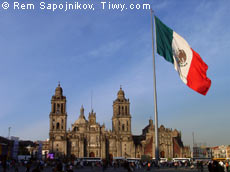 It is a frosty morning in Mexico. Christmas is just after one week – streets and windows of the shops are decorated with garlands of multi-colored lamps and bright green synthetic fur-trees. Santa-Claus is smiling friendly from all directions. Wrapped to the eyes city dwellers are rushing to their offices breathing out blue-grey clouds of steam. Some of them stop near the street booths with food that somehow resemble field canteens. Here for a very little money you can have a fast food as well as keep yourself warm near the stove, on which maize flat-breads - tacos are getting brown, generous fried egg dish with “tocineta”1 is ripening, generously covered with catchup “hot dogs” American way and, of course, strong coffee is prepared, the tempting aroma of which is difficult to resist.
It is a frosty morning in Mexico. Christmas is just after one week – streets and windows of the shops are decorated with garlands of multi-colored lamps and bright green synthetic fur-trees. Santa-Claus is smiling friendly from all directions. Wrapped to the eyes city dwellers are rushing to their offices breathing out blue-grey clouds of steam. Some of them stop near the street booths with food that somehow resemble field canteens. Here for a very little money you can have a fast food as well as keep yourself warm near the stove, on which maize flat-breads - tacos are getting brown, generous fried egg dish with “tocineta”1 is ripening, generously covered with catchup “hot dogs” American way and, of course, strong coffee is prepared, the tempting aroma of which is difficult to resist.
Along the Reforma
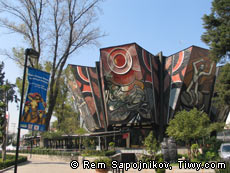 I used to be in Mexico before but transiently. If the air flights permitted, having armed with tourist map, in between the flights, I went sightseeing in the megapolis and its environment. Voyage in a decorated boat trajinera along the streams of Xochimilco, sunk in the depth of centuries at the feet of the Teotihuacan pyramids, energy power of David Alfaro Siqueiros frescos in "Polyforum", unforgettable panorama of Mexico, that is opened from the "Torre Latinoamericana" view-point – these and other impressions got rooted in my subconsciousness as some chipping marks. As if they were reminding me: this huge city is impossible to learn through sporadic “guerilla” attacks. And I am again in Mexican capital and, thank God, without that nervous feeling that I am late for some flight.
I used to be in Mexico before but transiently. If the air flights permitted, having armed with tourist map, in between the flights, I went sightseeing in the megapolis and its environment. Voyage in a decorated boat trajinera along the streams of Xochimilco, sunk in the depth of centuries at the feet of the Teotihuacan pyramids, energy power of David Alfaro Siqueiros frescos in "Polyforum", unforgettable panorama of Mexico, that is opened from the "Torre Latinoamericana" view-point – these and other impressions got rooted in my subconsciousness as some chipping marks. As if they were reminding me: this huge city is impossible to learn through sporadic “guerilla” attacks. And I am again in Mexican capital and, thank God, without that nervous feeling that I am late for some flight.
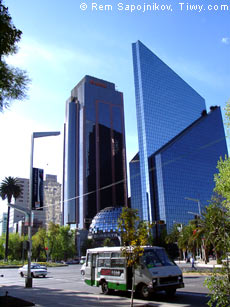 Acquaintance with the city almost necessarily begins with a walk along the main capital avenue – Paseo de la Reforma, built to the image of the Elysian Fields. Along it there is a crowd of banks, luxurious hotels and shopping centres with American and European names. Here is situated the tallest sky-scraper in Mexico and Latin America - "Torre Mayor", which is 225 meters high. Its construction lasted for five years and cost the company "Reichman International" 300 million dollars. Life support systems of “Torre” are fully computerised. The modern technologies ensure firmness of the sky-scraper in case of the most devastating earth-quake. And what about its own micro-climate! Even the omnipresent smog cannot penetrate behind the mirror walls of “Torre Mayor”.
Acquaintance with the city almost necessarily begins with a walk along the main capital avenue – Paseo de la Reforma, built to the image of the Elysian Fields. Along it there is a crowd of banks, luxurious hotels and shopping centres with American and European names. Here is situated the tallest sky-scraper in Mexico and Latin America - "Torre Mayor", which is 225 meters high. Its construction lasted for five years and cost the company "Reichman International" 300 million dollars. Life support systems of “Torre” are fully computerised. The modern technologies ensure firmness of the sky-scraper in case of the most devastating earth-quake. And what about its own micro-climate! Even the omnipresent smog cannot penetrate behind the mirror walls of “Torre Mayor”.
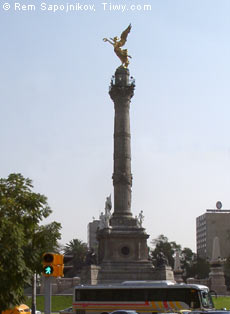 The angel that symbolises independence of Mexico proudly spread its gilded wings above the avenue on the dashing marble column. Dates are often appointed near the monument, and it is enough to say “let's meet at the Angel” so that not to be mistaken as to the place of meeting. Along the both sides of the avenue – there is a continuous stream of vehicles, with the small cylinder capacity cars dominating. Petrol is expensive in the country, and that is why an average Mexican driver will prefer economic “wolkswagen” and “pegeaut”. Within a busy city traffic they are more convenient and I used to make sure in it more than once, having made spurts from one district of the city to another on green taxi “bugs”.
The angel that symbolises independence of Mexico proudly spread its gilded wings above the avenue on the dashing marble column. Dates are often appointed near the monument, and it is enough to say “let's meet at the Angel” so that not to be mistaken as to the place of meeting. Along the both sides of the avenue – there is a continuous stream of vehicles, with the small cylinder capacity cars dominating. Petrol is expensive in the country, and that is why an average Mexican driver will prefer economic “wolkswagen” and “pegeaut”. Within a busy city traffic they are more convenient and I used to make sure in it more than once, having made spurts from one district of the city to another on green taxi “bugs”.
Usual for avenue la Reforma scene: flocks of tourists, taking pictures of the Angel, monument to Christopher Columbus, monument to Cuauhtemoc - last emperor of Aztecas and, at the same time, numerous monuments to national historic figures. It is worth mentioning that the capital authorities consider the project of “moving” a number of statues and monuments from the avenue edge so that they, as the director of department of architecture of National autonomous university Felipe Leal said, “should not resemble passengers waiting to get on the bus”. Indian hero Cuauhtemoc has already left busy crossroads of Reforma avenue and Insurgentes to the street Versalles whereas other Mexican politicians and activists are still waiting to be shifted into inner lanes of the avenue.
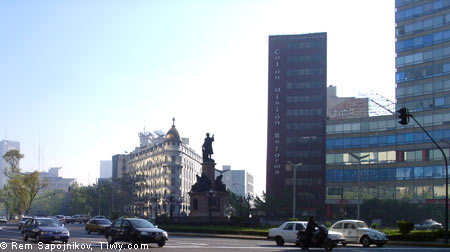
It was at Reforma when a curious incident happened to me. I paid attention to rather a big crowd near the building, paled by a high wall, rows of barbed wire and concrete obstacles. The guards with ready-to-shoot automatic rifles distrustfully peered at pedestrians. “City jail, I thought. And these modestly dressed tan-faced people with packages and bags are waiting to be received to give the parcels to relations and relatives, who got behind the bars”. To confirm my guess I approached a woman, who was trying to keep herself warm by wrapping into a woolen poncho. “No, it is not a jail, it is an embassy”. “You don't say so! - my surprise was not less. “Whose?” “The United States! And this line is for visas”- explained the woman. Previously unsmiling crowd started to giggle: “gringo” mistook embassy for jail. Of course about ten years ago it was difficult to imagine the protective measures of such scale around the embassies of the United States in all the countries of Latin America. But this is the epoch we live in. International terrorist organisations try to settle in the Western hemisphere. I'll say! The ideas of globalisation were optimistically “conceived” in underground headquarters of terrorism.
That is why Mexico, developing bilateral relations with the United States, advancing within the framework of North American Free Trade Agreement (NAFTA), cannot stay aside from the battles of its northern neighbour with terrorist groupings, drug-cartels, international criminal organisations. In principle the experience of such a large-scale cooperation between the USA and Mexico is present. It is sufficient to recollect that in the years of the Second World War when the Mexicans cooperated with the Roosevelt administration in the case of defeating the cells of the “fifth column” and Nazi agents on its territory. It was in this period when the active agents of FBI (CIA did not exist at that time) deputed to Mexico, Tampico, Veracruz, Acapulco and other cities, were given free hand to fight the common enemy. There is no doubt that at present the US special services carry out much bigger work in provision of its security in the “Southern underpinning”.
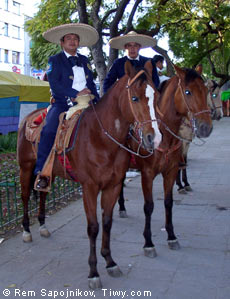 Mexico produced on me the impression of a calm city, in which the law and order guards, in fact, feel themselves masters of the situation. The police seem to be everywhere. And we mean not only the center of the capital, tourist “Zona Rosa” and Reforma, but also such areas as Coyoacan, San Angel, Iztacalco, V.Carranza and others. Mexican capital that used to be notorious for large scale criminal actions, especially kidnapping, the experience of the USA has been taken into account. It is too early to speak about the final results. Nevertheless, the chief of public security of the municipal district Marcelo Ebrard, working in close contact with Rudolph Giuliani, the Giuliani, who, being a Mayor of New-York, reduced crime rate more than half, believes that the fight against criminality will be completed in victory.
Mexico produced on me the impression of a calm city, in which the law and order guards, in fact, feel themselves masters of the situation. The police seem to be everywhere. And we mean not only the center of the capital, tourist “Zona Rosa” and Reforma, but also such areas as Coyoacan, San Angel, Iztacalco, V.Carranza and others. Mexican capital that used to be notorious for large scale criminal actions, especially kidnapping, the experience of the USA has been taken into account. It is too early to speak about the final results. Nevertheless, the chief of public security of the municipal district Marcelo Ebrard, working in close contact with Rudolph Giuliani, the Giuliani, who, being a Mayor of New-York, reduced crime rate more than half, believes that the fight against criminality will be completed in victory.
“Wax rating” of Mexico
The “Museum tour” of the capital can be started with the wax figures Museum in Mexico. It is very interesting to cast a look , which of the Mexicans of the past and present was honoured with this “wax rating”? Naturally these are the presidents. They are represented in full scope staring from Guadalupe Victoria to Vicente Fox - no discrimination at all! Even Carlos Salinas de Gortari, whose ruling period was marked by notorious corruption and other scandals, gleams his bald head among his colleagues.
Here are others – the Indian chief Cuauhtemoc, independence forerunner Miguel Hidalgo, “minion”-emperor Maximillian, poetess-monk of the 17th century Juana Ines de la Cruz. The visitors are menacingly looked at by guerilla leaders Emiliano Zapata and Pancho Villa, who resembled the Russian Civil war hero Gregory Kotovsky and died same way as he did under strange, undiscovered till now circumstances. The three outstanding muralists - Jose Clemente Orozco, David Alfaro Siqueiros and Diego Rivera occupy the honorary place. Even made of such soft and undurable material as wax, they monumentally tower in tight for them exhibition space. During the life, the artists often had conflicts because of political and artistic reasons. Fleeting transient arguments! And what an indelible trace in world culture!
Wax figure masters could not leave aside such prominent representatives of Mexican artistic and music world: Mario Moreno "Cantinflas", Jorge Negrete, Pedro Infante, Dolores del Rio, Maria Felix, Pedro Vargas, Agustin Lara, Veronica Castro and many others. This star cohort includes the popular singer Thalia, the sale of her CDs used to break all national and Latin American records. Chase for rating, American husband (ex-president of “Sony Music”), attempts to sing in English to win the US audience, imitation of cheeky-shameless singers of “youth wave”, - all this slightly saddened familiar to music lover image of “authentic Mexican” - fiery-passionate Thalia. But still, probably, hoping for her return to home, to national roots, “into place”, the singer was placed in the Wax Pantheon of the “very-very Mexican men and women”. It is true, that the statue had to be remodelled: “extra” kilograms of wax caused indignation of the singer, whose slenderness and grace of figure do not arouse any doubts. So the Wax Thalia No.2 nowadays is demonstrated in Mexican capital, and Thalia No.1 (rejected version) has been sold to some provincial museum. Mexicans are economical. The assets should not be wasted.
There is another exhibit in the Museum - Subcomandante Marcos. Clad in black uniform, in Alpine mask - “pasamoñtanas”, in leather belts, but without his world-wide known pipe. Visitors to the Museum stole from the famous guerilla leader from the state Chiapas more than a dozen of pipes for souvenirs, and the Museum authorities decided, with a view of economy, to sacrifice in this case the truth of life. I, as probably others, was surprised that Marcos was “denied” the honorable , but deserved place near Zapata and Villa. He was pushed aside, you may say, to the backyard of the exposition, under the stairs leading to the basement of the museum, devoted to such monsters and scarecrows as Llorona, Freddy Kruger, Chucky and serial psycho killer Hannibal. Could the malicious bacillus of social opposition penetrate the sterile politically indifferent atmosphere of the museum?
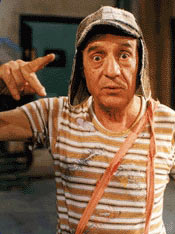 To my surprise the heroes of one of the most popular in Mexico and the whole of Latin America TV serials “Chavo del 8” did not get to the museum. The serial tells about the life of inhabitants of the most common residential house at the outskirts of Mexico. It was made day after day in 1972-1978. Since then it broke all the records of staying at the world TV screen – more than 30 years! And still it enjoys steady success among young and old spectators in dozens of countries! One and the same children heroes used to take part in modest comic scenes: homeless and permanently hungry boy Chavo, his successful friend Quico and naughty girl-friend Chilindrina. The world of adults in the serial is represented by a quarrelsome mummy of Quico – doña Florinda, by her indecisive admirer - tall primary school teacher Jirafales, father of Chilindrina – don Ramon, permanently getting into trouble and therefore getting punches, elderly señorita Clotilde resembling the witch, as well as the house owner señor Barriga. Everybody knows these heroes in Latin America!
To my surprise the heroes of one of the most popular in Mexico and the whole of Latin America TV serials “Chavo del 8” did not get to the museum. The serial tells about the life of inhabitants of the most common residential house at the outskirts of Mexico. It was made day after day in 1972-1978. Since then it broke all the records of staying at the world TV screen – more than 30 years! And still it enjoys steady success among young and old spectators in dozens of countries! One and the same children heroes used to take part in modest comic scenes: homeless and permanently hungry boy Chavo, his successful friend Quico and naughty girl-friend Chilindrina. The world of adults in the serial is represented by a quarrelsome mummy of Quico – doña Florinda, by her indecisive admirer - tall primary school teacher Jirafales, father of Chilindrina – don Ramon, permanently getting into trouble and therefore getting punches, elderly señorita Clotilde resembling the witch, as well as the house owner señor Barriga. Everybody knows these heroes in Latin America!
Serial authors and performer of the part of Chavo – Roberto Gomez Bolaños, actor, scriptwriter and director are frequently called the geniuses of the Mexican TV. He put all the burden of organisational and artistic work on his shoulders and, what is most important, gathered “many a little” talented actor cast. Parts of children were played by adults, and very well! Gomez Bolaños started to play the 9 year old Chavo at the age of 43. And reincarnation could not be disbelieved. It is a pity, but nothing is permanent in the world of art . The time has come and the perfect company fell apart, basically, due to the reasons of financial nature, and partially - due to reciprocal actor's jealousy. Having left the scenery of their very well lived-in yard, the actors, earning their living, continued to use attractive to spectators artistic masks. Almost all of them acquired “personal” circus companies and started touring the Latin American countries. Heroes of the serial “Chavo del 8” became cult figures on the continent, their shocking words and remarks entered the everyday life, they are often quoted by politicians, journalists and renowned intellectuals. The popularity of the serial heroes can be compared with the one of the comic “trinity” of the Soviet epoch – Booby, Coward and Stager.
1 Tocineta (span.) - smoked pork bacon, cut in strips.
Jump to next page »
|

